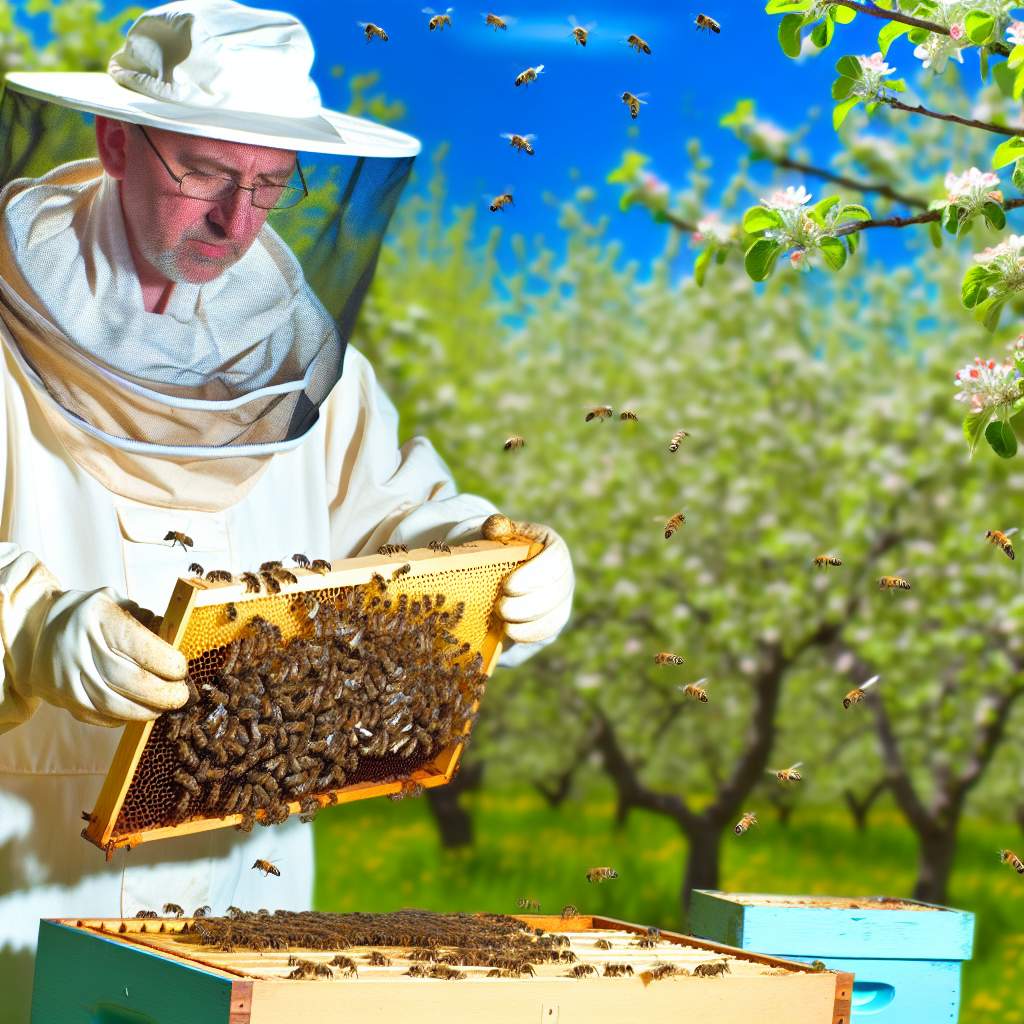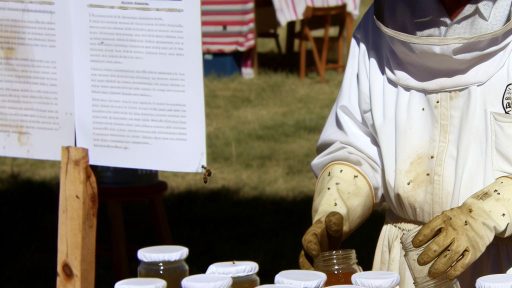Introduction to the Importance of Bee Health in Agriculture
Bees play a crucial role in agriculture.
They pollinate a vast array of crops, enhancing food production.
Without bees, many fruits and vegetables would decline significantly.
Moreover, bee health directly impacts biodiversity.
A healthy bee population supports diverse ecosystems.
In the USA, beekeepers face numerous challenges.
Pests and diseases threaten bee colonies every year.
Consequently, protecting bee health is essential for agricultural sustainability.
Farmers rely on healthy bees for crop yields.
Thus, understanding bee health challenges is vital.
Challenges Facing Bee Colonies
Bees encounter various pests, such as the Varroa mite.
These mites attach to bees and weaken their health.
Additionally, diseases like American foulbrood affect colonies.
Both pests and diseases reduce bee populations dramatically.
Furthermore, habitat loss due to urban development impacts bees.
Transform Your Agribusiness
Unlock your farm's potential with expert advice tailored to your needs. Get actionable steps that drive real results.
Get StartedInadequate food sources also harm their survival.
Consequently, beekeepers must actively manage these threats.
The Role of Beekeepers in Bee Health
Beekeepers have a responsibility to monitor their colonies.
Regular inspections can help detect problems early.
Moreover, beekeepers should implement effective pest management strategies.
This includes using treatments and natural remedies.
In addition, relocating hives can provide better resources.
Beekeepers also educate themselves about bee diseases.
Regular training ensures they stay updated with best practices.
Ultimately, informed beekeepers can ensure healthier colonies.
Common Pests Affecting Bee Colonies
Introduction to Bee Pests
Bees face numerous threats in their environments.
Pests can severely impact colony health and productivity.
Understanding these pests is vital for effective management.
Varroa Mites
Varroa mites are among the most harmful pests.
They attach to bees and feed on their bodily fluids.
Additionally, they spread viruses that can devastate colonies.
Identifying signs of infestation quickly is crucial.
- Look for bees with deformed wings.
- Check for lethargic behavior among bees.
- Monitor for increased bee mortality rates.
Wax Moths
Wax moths can cause significant damage to the comb.
Their larvae consume beeswax, compromising the hive structure.
Strong colonies can usually manage small infestations.
However, weak colonies are highly vulnerable.
Regular inspections can help detect these pests early.
Small Hive Beetles
Small hive beetles are another concern for beekeepers.
Their larvae feed on honey, pollen, and beeswax.
Showcase Your Farming Business
Publish your professional farming services profile on our blog for a one-time fee of $200 and reach a dedicated audience of farmers and agribusiness owners.
Publish Your ProfileThis feeding can lead to fermenting honey and colony collapse.
Prevention strategies include maintaining strong colonies.
- Ensure proper hive management techniques.
- Regularly clean and inspect hive equipment.
Other Notable Pests
Numerous other pests threaten bee populations.
These include ants, rodents, and various beetles.
Each pest has unique management strategies.
Staying informed about local pest threats is essential.
Common Diseases in Bees: Symptoms and Prevention
Understanding Bee Diseases
Bee colonies face various threats from diseases.
Recognizing these diseases early is crucial for prevention.
Thus, understanding symptoms helps beekeepers protect their hives.
American Foulbrood
American Foulbrood (AFB) is a serious bacterial disease.
This disease affects the larvae of honeybees.
Symptoms include dead larvae that resemble melted candle wax.
Additionally, a strong odor often accompanies infected hives.
Preventing AFB involves regular inspections and clean equipment.
Beekeepers should destroy infected colonies to stop the spread.
Varroa Mite Infestation
Varroa mites pose a significant threat to bee colonies.
They attach to bees and feed on their bodily fluids.
Infestations lead to weakened bees and disease transmission.
Look for signs such as disfigured wings and reduced hive populations.
Effective treatment options include miticides and drone removal.
Regular monitoring helps manage mite levels successfully.
Nosema Disease
Nosema is a fungal disease affecting adult bees.
This disease impacts their digestive system.
Symptoms include dysentery and reduced honey production.
To prevent Nosema, ensure proper hive ventilation.
Beekeepers should maintain strong colonies to reduce stress.
Chalkbrood
Chalkbrood is another fungal disease affecting honeybee larvae.
The infected larvae turn into a chalk-like substance.
This disease thrives in cool, damp conditions.
To minimize risks, maintain proper hive hygiene.
Additionally, beekeepers should emphasize robust colony management.
Preventive Measures
Regular inspections are essential for disease prevention.
By checking for symptoms, beekeepers can act quickly.
Moreover, managing the hive environment supports bee health.
Utilize good biosecurity practices in all beekeeping operations.
Summary of Best Practices
- Conduct regular hive inspections.
- Practice robust hygiene protocols.
- Monitor and manage pests effectively.
- Utilize resistant bee strains where possible.
Learn More: Indoor Gardening Ideas for Utilizing Vertical Farming in Small Areas
Integrated Pest Management Strategies for Beekeepers
Understanding Integrated Pest Management
Integrated Pest Management (IPM) emphasizes combining different strategies for pest control.
This method reduces pesticide use and environmental impact.
IPM incorporates biological, cultural, and mechanical control methods.
Additionally, it promotes regular monitoring and assessment of bee health.
Showcase Your Farming Business
Publish your professional farming services profile on our blog for a one-time fee of $200 and reach a dedicated audience of farmers and agribusiness owners.
Publish Your ProfileRegular Monitoring of Bee Colonies
Regular inspections are crucial for keeping bees healthy.
Inspect colonies every two weeks during peak season.
During these inspections, check for signs of pests and disease.
Take note of any abnormal behaviors or population declines.
Identifying Common Pests and Diseases
Familiarize yourself with common pests that affect bee colonies.
Varroa mites pose significant threats to bee health.
Small hive beetles can also disrupt colony productivity.
Additionally, monitor for diseases such as Nosema and American foulbrood.
Implementing Biological Controls
Biological controls involve using natural enemies of pests.
Encourage beneficial insects that prey on harmful species.
These include ladybugs, lacewings, and predatory mites.
By supporting biodiversity, you enhance natural pest control.
Cultural Practices for Healthy Colonies
Cultural practices can significantly improve colony health.
Maintain good hygiene by regularly cleaning hive equipment.
Rotate brood frames to encourage natural pest control.
Provide adequate ventilation to reduce moisture buildup in hives.
Mechanical Controls
Mechanical controls can effectively deter pests.
Use traps specifically designed for varroa mites or small hive beetles.
Physical barriers, like screens, can protect hives from pests.
Regularly check and maintain these devices for effectiveness.
Use of Chemical Controls Sparingly
If other methods fail, use chemical controls as a last resort.
Choose selective pesticides that target specific pests.
Always follow label instructions for application rates.
Consider timing applications to minimize harm to beneficial insects.
Education and Resource Utilization
Stay informed about best practices in beekeeping.
Participate in local beekeeping associations and workshops.
Utilize resources such as extension services for advice.
Networking with other beekeepers can provide valuable insights.
See Related Content: How to Choose the Right Seeds for High-Yield Microgreens Farming
Natural Remedies and Organic Treatments for Bee Pests
Understanding Common Bee Pests
Bee colonies face threats from various pests.
Common pests include Varroa mites, wax moths, and small hive beetles.
Recognizing these pests early is essential for effective management.
Natural Remedies to Combat Pests
Several natural remedies can protect bee colonies.
Essential oils are a popular choice among beekeepers.
Oils like thyme, peppermint, and tea tree can deter pests.
Mix these oils with water and spray them on your hives.
Using Diatomaceous Earth
Diatomaceous earth is a natural pest control option.
It works by damaging the exoskeletons of insects.
Sprinkle food-grade diatomaceous earth around hives to discourage pests.
Encouraging Beneficial Insects
Creating a habitat for beneficial insects can help.
Showcase Your Farming Business
Publish your professional farming services profile on our blog for a one-time fee of $200 and reach a dedicated audience of farmers and agribusiness owners.
Publish Your ProfilePredators like ladybugs and lacewings can control pest populations.
Planting diverse flowers invites these beneficial insects to your garden.
Implementing Organic Treatments
Organic treatments are effective for maintaining healthy hives.
Oxalic acid is a popular treatment for varroa mites.
Ensure to follow safety guidelines when using organic acids.
Regular Hive Inspections
Conduct regular inspections to monitor colony health.
Look for signs of pests and diseases during each visit.
Early detection can lead to more successful treatment options.
Maintaining Strong Colonies
A healthy colony is better equipped to fight off pests.
Provide ample food and floral resources to support bee health.
Invest in good genetics by selecting strong queen bees.
Educating Yourself and Other Beekeepers
Stay informed about new pest management techniques.
Engage in local beekeeping groups for shared knowledge.
Education is key to successfully combating pests and diseases.
Uncover the Details: Seasonal Gardening for Drought-Resistant Crops
The Role of Nutrition in Strengthening Bee Immunity
Importance of Nutrition
Proper nutrition is essential for bee health and immunity.
Nutritional deficiencies can lead to weakened immune systems.
Healthy bees are more resilient to diseases and pests.
Main Nutritional Needs
Bees require proteins, carbohydrates, vitamins, and minerals.
Proteins support brood development and colony growth.
Carbohydrates provide energy for foraging and hive activities.
Essential vitamins enhance immunity and overall health.
Types of Feed
Natural nectar and pollen are primary food sources for bees.
Supplemental feeding can help during times of scarcity.
- Pollen substitutes offer essential nutrients in low-pollen seasons.
- Sugar syrup can help boost energy during winter months.
- Proprietary bee feeds may also provide balanced nutrition.
Monitor Nutritional Status
Regularly assess the health of bee colonies.
Check for signs of malnutrition or illness.
Adjust feeding strategies based on the season and colony needs.
Diversity in Foraging
Diverse foraging improves bees’ nutritional intake.
Encouraging a variety of flowering plants supports biodiversity.
Planting native flowers provides essential nutrients for bees.
Gain More Insights: DIY Garden Projects for Greenhouse Farming

Monitoring and Surveillance Techniques for Bee Colonies
Importance of Regular Monitoring
Regular monitoring of bee colonies is crucial for their health.
This process helps identify potential threats sooner.
Consequently, beekeepers can implement timely interventions.
Visual Inspection Techniques
Visually inspecting hives allows beekeepers to assess their conditions.
Observing the bees’ behavior provides valuable insights.
Healthy bees exhibit specific flight patterns and activity levels.
Look for signs of disease such as abnormal bee behavior.
Additionally, monitor for pests like Varroa mites.
Utilizing Monitoring Equipment
Using monitoring equipment enhances surveillance efforts.
Showcase Your Farming Business
Publish your professional farming services profile on our blog for a one-time fee of $200 and reach a dedicated audience of farmers and agribusiness owners.
Publish Your ProfileTools like sticky boards can trap pests for examination.
Thermal cameras detect abnormal hive temperature variations.
Moreover, sound analysis helps identify issues within the colony.
Investing in technology streamlines monitoring processes.
Recording and Analyzing Data
Consistently recording data from inspections is vital.
This information helps identify trends over time.
Analyzing the data facilitates proactive measures.
For instance, tracking pest populations guides treatment decisions.
Engaging in Community Practices
Connecting with local beekeepers enhances collective monitoring efforts.
Sharing experiences fosters knowledge about pest management.
Participating in local beekeeping associations provides additional resources.
Such collaborations benefit all involved in beekeeping.
Legal and Regulatory Measures for Bee Safety in the USA
Overview of Current Regulations
The United States has several laws aimed at protecting bee populations.
These regulations focus on preventing diseases and controlling pests.
The Federal Insecticide, Fungicide, and Rodenticide Act regulates pesticide usage.
Additionally, the Animal Health Protection Act addresses bee health management.
State-Level Initiatives
States also implement their own measures to support bee safety.
State departments of agriculture commonly oversee these initiatives.
Moreover, many states require beekeepers to register their hives.
This registration helps monitor bee populations effectively.
Pest and Disease Management Programs
Many states have established pest and disease management programs.
These programs often provide education and resources to beekeepers.
For example, local workshops can teach management techniques.
Collaboration with Research Institutions
Collaboration with research institutions is critical for bee safety.
Many universities conduct studies on bee health and diseases.
Research findings influence policy decisions at both state and federal levels.
Funding for Bee Research
The USDA National Institute of Food and Agriculture provides funding for research.
This funding supports initiatives that enhance bee health and resilience.
Public Awareness Campaigns
Public awareness is vital to promote bee conservation efforts.
Many organizations run campaigns to educate the public about bees.
These campaigns often focus on the importance of pollinators in agriculture.
Community Engagement
Engaging local communities enhances bee protection efforts.
Community gardens and urban beekeeping initiatives promote awareness.
These activities encourage local populations to support bee habitats.
Challenges and Future Directions
Despite existing measures, challenges remain in bee protection.
Climate change and habitat loss significantly impact bee populations.
Future regulations must address these evolving challenges comprehensively.
Additionally, more funding for research on climate impacts is essential.
Collaboration across states can enhance the effectiveness of regulations.
Community and Cooperative Efforts to Protect Bee Populations
Importance of Local Beekeeping Groups
Local beekeeping groups play a crucial role in protecting bee colonies.
Showcase Your Farming Business
Publish your professional farming services profile on our blog for a one-time fee of $200 and reach a dedicated audience of farmers and agribusiness owners.
Publish Your ProfileThey serve as a support network for novice and experienced beekeepers.
In addition, these groups promote best practices in bee management.
They share knowledge on pest control and disease prevention methods.
Organizing Community Workshops
Community workshops enhance public awareness of bee health issues.
These workshops provide hands-on training for beekeepers and enthusiasts.
Participants learn about the latest research on bee diseases.
Furthermore, workshops can cover proper apiary management techniques.
Collaborative Research Initiatives
Collaborative research initiatives yield valuable insights into bee health.
Beekeepers, scientists, and agricultural organizations often join forces.
This collaboration fosters innovative solutions for pest management.
In addition, it aids the study of disease resistance in bee populations.
Creating Pollinator-Friendly Communities
Communities can promote pollinator-friendly practices in urban planning.
Planting native flowers encourages bee visitation and habitat restoration.
Homeowners can also reduce pesticide use to protect local bees.
Additionally, school programs can engage students in bee conservation.
Engagement with Local Government
Advocating for supportive local policies benefits bee populations.
Civic leaders can create regulations that protect pollinator habitats.
Moreover, they can fund initiatives that support sustainable beekeeping.
Engaging local government helps raise awareness about the importance of bees.
Building Community Awareness Campaigns
Awareness campaigns can educate the public on bee threats.
These campaigns may use social media and local events for outreach.
Collaborating with local schools can enhance the campaign’s reach.
Such efforts encourage community actions for bee protection.




